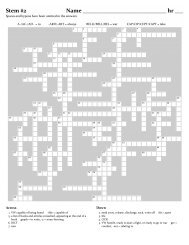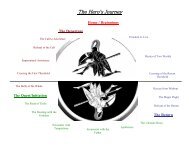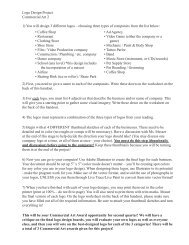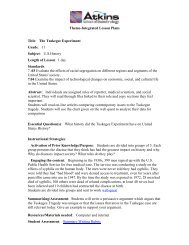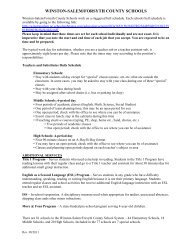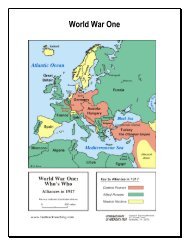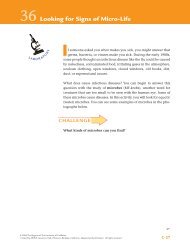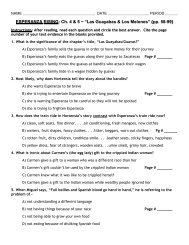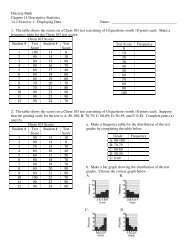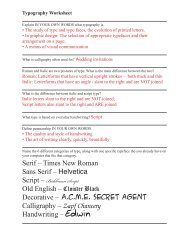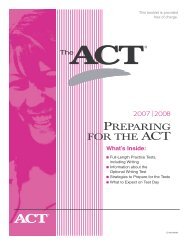You also want an ePaper? Increase the reach of your titles
YUMPU automatically turns print PDFs into web optimized ePapers that Google loves.
<strong>17</strong> Gas ExchangeL A B O R ATO R YYour blood transports the nutrients that you eat to differentparts of your body. It also carries oxygen from your lungs toother organs and tissues. With every breath you take, you inhale oxygenand exhale carbon dioxide. Your body uses the oxygen to getenergy from food. When your body breaks down food, it produceswastes. One of the wastes is carbon dioxide.NoseExhaled breath withcarbon dioxide wasteAirMouthTrachea(windpipe)LungsAlveoli(air sacs)A thin layer oftissue formsthe walls ofthe air sacsBlood coming tolungs from body(carries carbondioxide waste)Blood leaving lungs(carries oxygento body)Figure 1: Human Respiratory SystemB-36Seventeenth Street StudiosScience and Life IssuesFig. SE1-<strong>17</strong>-016892-01© 2006 The Regents of The University of California.Created by SEPUP, Lawrence Hall of Science, Berkeley, California. Adapted with permission. All rights reserved.C M Y K
Gas Exchange • <strong>Act</strong>ivity <strong>17</strong>Indicators (IN-duh-kay-ters) are chemicals that change their appearancein different types of solutions. You will work with the indicatorbromthymol (brome-THY-mall) blue, also known as BTB. BTB can beeither blue or yellow. When added to a solution containing carbondioxide, BTB is yellow.Both solutions contain the indicator BTB. Which cup has a solution containing carbon dioxide?CHALLENGEHow much carbon dioxide is in your exhaled breath?➢© 2006 The Regents of The University of California.Created by SEPUP, Lawrence Hall of Science, Berkeley, California. Adapted with permission. All rights reserved.B-37
<strong>Act</strong>ivity <strong>17</strong> • Gas ExchangeMATERIALSFor each group of four students1 dropper bottle of bromthymol blue (BTB) indicator5 plastic cupssupply of waterFor each pair of students1 dropper bottle of 0.05 M sodium hydroxide1 SEPUP tray1 dropper1 30-mL graduated cupFor each student1 1-gallon plastic bag1 straw1 stir stickaccess to a wall clock or watch with a second handSAFETYIn this activity, you will be blowing through a straw into chemicals.Do not inhale through the straw! Breathe in through your nose andexhale through your mouth. If you accidentally swallow liquid,rinse your mouth thoroughly and drink plenty of water. Be sure totell your teacher.PROCEDUREPart One: Using BTB to Test for Carbon Dioxide1. Work with your partner to add 5 mL water to each of the five largecups (A–E) of your SEPUP tray. Use the 30-mL graduated cup tomeasure the water.2. Add 2 drops of BTB to each cup and stir.3. Create a data table to record the initial and final colors of thesolutions in each cup. Record the initial colors now. Cup A willprovide a control.B-38© 2006 The Regents of The University of California.Created by SEPUP, Lawrence Hall of Science, Berkeley, California. Adapted with permission. All rights reserved.
Gas Exchange • <strong>Act</strong>ivity <strong>17</strong>4. Use your dropper to bubble air into Cup B. Place the dropperinto the solution and press the air out of the bulb. Before releasingthe bulb, remove the tip from the solution. This will preventuptake of solution into the dropper. (If you accidentally get solutioninto the dropper, simply squirt it back into Cup B.) Repeatthis for 15 seconds.5. Record the final color of the solution in Cup B in your data table.6. Add 3 drops of 0.05 M sodium hydroxide to Cup C. Record thefinal color in your data table.7. Unwrap your straw and place one end in Cup D. Take a deepbreath, and then gently blow through the straw for 15 seconds.(Remember not to inhale through the straw!) Record the finalcolor of the solution in Cup D in your data table.8. Have your partner blow through a clean straw into Cup E for 15seconds. (Remember not to inhale through the straw!) Record thefinal color in your data table.9. Add 3 drops of sodium hydroxide to Cups D and E. In your sciencenotebook, record any changes that you observe.10. Work with your partner to complete Analysis Questions 1 and 2.Part Two: Using BTB to Measure Carbon Dioxidein Exhaled Breath11. Work with another pair of students to set up a control:a. Measure 10 mL of water using the 30-mL graduated cup.b. Add 3 drops of BTB to the graduated cup and stir.c. Pour the BTB solution into a large plastic cup. This solutionwill be the control for every member of your group.12. Have each person in your group set up his or her own bag of BTBsolution:a. Measure 10 mL of water using the 30-mL graduated cup.b. Add 3 drops of BTB to the graduated cup and stir.c. Pour the BTB solution into your own 1-gallon plastic bag.➢© 2006 The Regents of The University of California.Created by SEPUP, Lawrence Hall of Science, Berkeley, California. Adapted with permission. All rights reserved.B-39
<strong>Act</strong>ivity <strong>17</strong> • Gas Exchange13. Remove the air from your plastic bag byslowly flattening it. Be careful not to spillany of the BTB solution out of the bag.While keeping the air out of the bag, placea straw in the mouth of the bag. Make anair-tight seal by holding the mouth of thebag tightly around the straw.14. Be sure you are sitting down. Then fillthe bag with air from your lungs byblowing through the straw until thebag is fully inflated. When you finishblowing, pull out the straw. As youpull out the straw, squeeze the bagtightly shut so no air escapes.15. Holding the bag closed, shake thebag vigorously 25 times.16. Pour the BTB solution from the baginto a clean, empty plastic cup.<strong>17</strong>. How much carbon dioxide is in your exhaled breath? You can find outby counting how many drops of sodium hydroxide are needed tomake your BTB solution the same color as the control:a. Add 1 drop of sodium hydroxide to your plastic cup.b. Gently stir the solution and wait at least 10 seconds.c. Record in your science notebook that you added 1 drop.d. Compare the color of your solution to the control. Is it the samecolor as the control for at least 30 seconds?If your answer is no, repeat Steps <strong>17</strong>a–d. Be sure to keep track of thetotal number of drops!If your answer is yes, go on to Step 18.18. In your science notebook, record the total number of drops it tookto change your solution back to the same color as the control.Then record your total on the class data table.19. Draw a bar graph with the class results. Remember to title yourgraph and label the axes!B-40© 2006 The Regents of The University of California.Created by SEPUP, Lawrence Hall of Science, Berkeley, California. Adapted with permission. All rights reserved.
Gas Exchange • <strong>Act</strong>ivity <strong>17</strong>EXTENSION 1Do you exhale more carbon dioxide after you hold your breath? Findout by modifying and repeating Part Two of the Procedure.ANALYSISPart One: Using BTB to Test for Carbon Dioxide1. What was the purpose of the solution in Cup A?2. a. Which of the solutions in Part One contained carbon dioxide?Support your answer with evidence from your experimentalresults.b. What does this tell you about the exhaled breath of humanbeings?➢© 2006 The Regents of The University of California.Created by SEPUP, Lawrence Hall of Science, Berkeley, California. Adapted with permission. All rights reserved.B-41
<strong>Act</strong>ivity <strong>17</strong> • Gas ExchangePart Two: Using BTB to Measure Carbon Dioxidein Exhaled Breath3. Review the class data table. What was the range of carbon dioxidein exhaled breath (as measured by drops of sodium hydroxide)?Hint: You looked at the range of class data in <strong>Act</strong>ivity 9,“Data Toss.”4. Look again at Figure 1, “Human Respiratory System.” Consideringall the oxygen that has to get into your blood and all the carbondioxide that has to escape from your blood, why do you thinkthe inside of the lung is structured the way it is?5. a. Were the data collected in Part One qualitative or quantitative?Explain.b. Were the data collected in Part Two qualitative or quantitative?Explain.6. a. Look carefully at Figure 1, “Human Respiratory System.” Whatare some of the important structures in the respiratory system?b. Explain how gases are exchanged within the respiratorysystem.EXTENSION 2How do you think your body gets more oxygen when you exercise? Doyou breathe faster (take more breaths per minute)? Or do you absorbmore oxygen from the air with each breath? Use what you learned inthis activity to develop an experiment to test your hypothesis.B-42© 2006 The Regents of The University of California.Created by SEPUP, Lawrence Hall of Science, Berkeley, California. Adapted with permission. All rights reserved.



